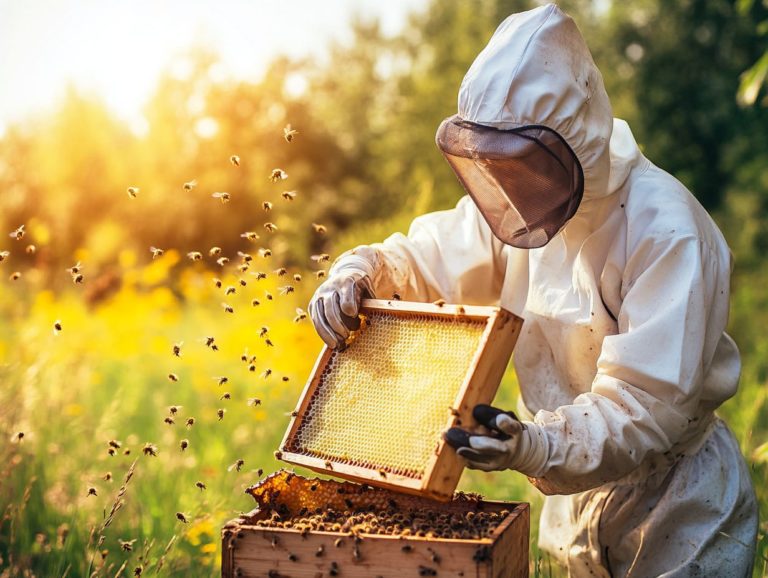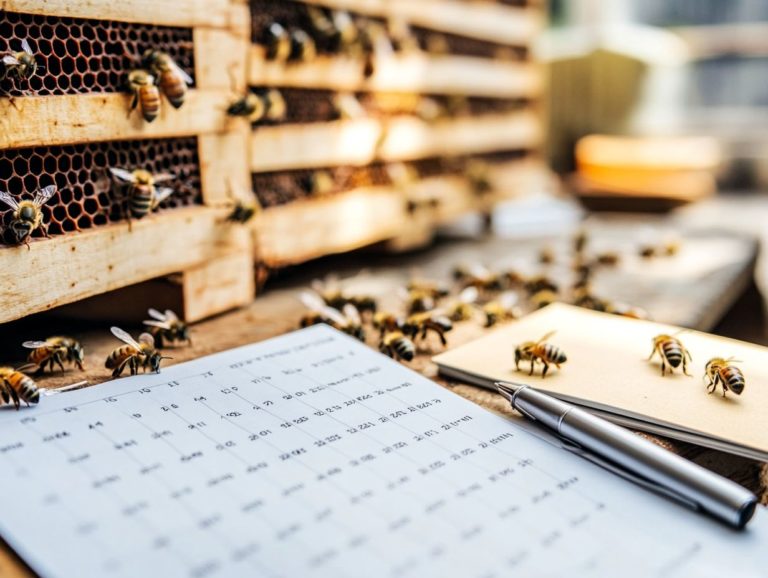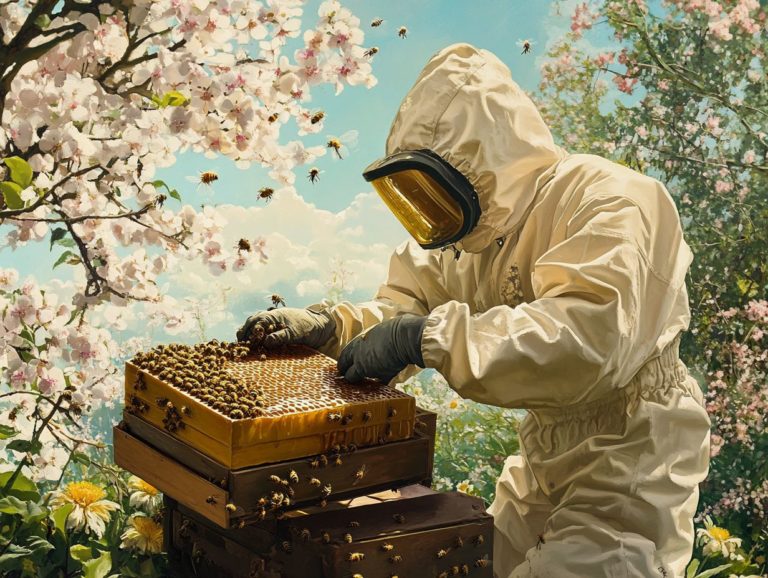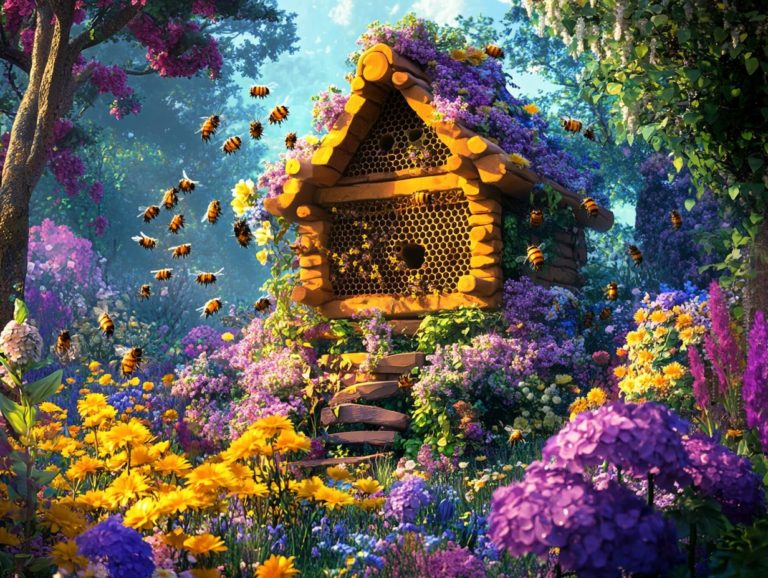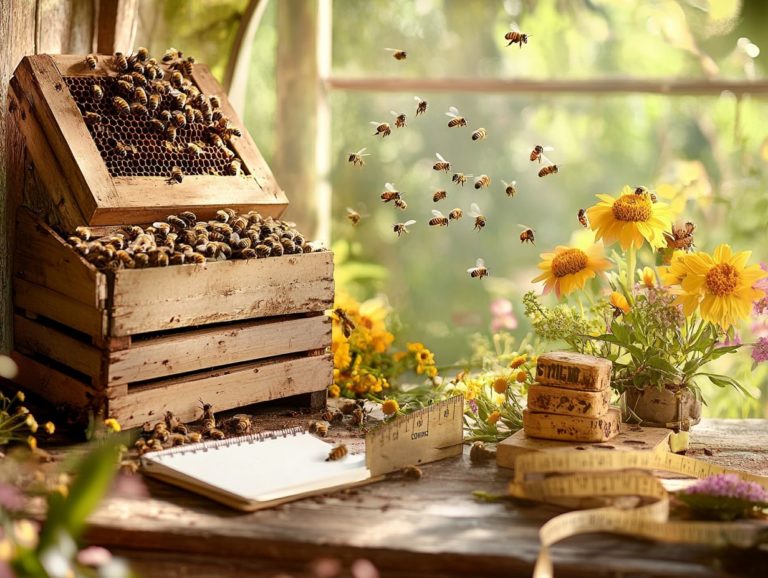The Role of Drone Bees in Hive Management
Don t miss out on discovering how these buzzing contributors are essential for a thriving hive! Drone bees frequently remain overlooked in conversations about hive management, yet their contributions are vital to the overall health, hive population, and productivity of a colony.
Join us as we explore the fascinating world of drone bees their identity, distinct roles within the hive, and their impact on pollination, genetic diversity, hive defense, and even temperature regulation.
You ll also learn how to identify and manage these crucial bees, including understanding their pheromones (chemical signals that bees use to communicate), while gaining insight into the future of drone bees in the ever-evolving landscape of beekeeping.
Uncover the often-neglected significance of these buzzing contributors and appreciate their vital role in hive dynamics and the ecosystem!
Contents
- Key Takeaways:
- The Role of Drone Bees in Hive Management
- The Importance of Drone Bees in Hive Management
- How to Identify Drone Bees in a Hive
- How to Manage Drone Bees in a Hive
- The Future of Drone Bees in Hive Management
- Frequently Asked Questions
- What is the role of drone bees in hive management and hive activity?
- How do drone bees contribute to the health of the colony?
- Are drone bees necessary for a functioning colony?
- Do drone bees collect nectar or pollen like worker bees or foragers?
- How many drone bees are typically found in a colony?
- What happens to drone bees at the end of the season and to their drone lifespan?
Key Takeaways:
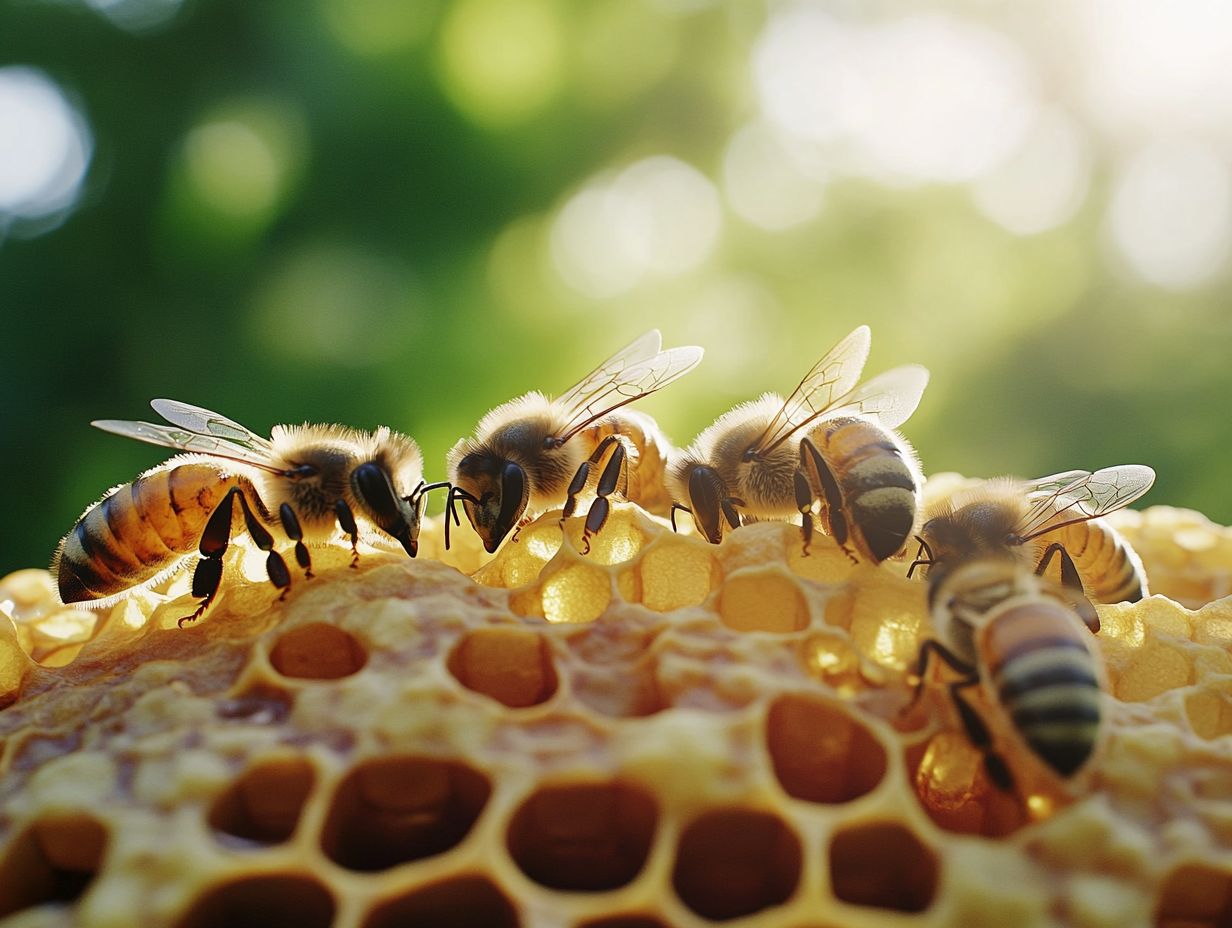
- Drone bees play a crucial role in hive management, aiding in pollination, genetic variety, temperature regulation, and queen mating. Their presence significantly affects hive activity.
- It is important to manage and monitor drone bees in a hive properly to ensure a healthy and productive colony. They also help with brood development and hive maintenance.
- The future of drone bees in hive management is constantly evolving with technological advancements that may impact the beekeeping industry.
The Role of Drone Bees in Hive Management
Drone bees are pivotal to the intricate management of a beehive, serving as the male counterparts to the diligent worker bees. Their role is essential for preserving the genetic variety within the colony and aiding in hive maintenance.
While worker bees take charge of foraging, defending the hive, comb building, and nurturing the young, drones have a singular focus: mating with the queen during her mating flights. This presence is not merely a formality; it significantly enhances the overall health and productivity of the colony.
By ensuring successful reproduction, drones facilitate crucial hive activities that are necessary for securing food resources and boosting honey production. They also influence egg-laying rates and overall hive repair.
What Are Drone Bees?
Drone bees are the male counterparts of a hive, easily distinguished by their larger size and unique physical traits compared to worker bees and the queen bee.
With their robust build, drones flaunt broader bodies and larger eyes, perfectly tailored for their primary mission: mating with a queen. Unlike their female counterparts, drones are devoid of stingers and don’t engage in foraging or maintaining the hive. They exist solely to reproduce; developing from unfertilized eggs, they possess specialized reproductive organs designed for the critical nuptial flights (the mating flights of the queen).
This distinct life cycle sets them apart from females, as they typically emerge later in the season and are only produced when the colony is strong enough. This reflects their vital role in maintaining the genetic diversity of the hive.
What Is the Purpose of Drone Bees in a Hive?
The primary role of drone bees in a hive is to mate with the queen during her mating flights, a vital process for ensuring genetic diversity and colony health within the hive.
These flights typically take place on warm, sunny days when the queen is ready for mating, requiring precise timing to align with the availability of the drones. A successful mating not only provides the queen with the essential sperm she needs but also plays a critical role in the genetic health of the entire hive. A diverse genetic pool among the bees enhances the colony’s resilience against diseases and environmental changes.
This mating behavior significantly affects hive activity levels. A healthy queen can lay more eggs, fostering robust colony growth that directly contributes to the overall vitality of the hive.
Understanding drone bees is crucial for any beekeeper aiming for a successful and sustainable hive.
How Many Drone Bees Are in a Hive?
The number of drone bees in a hive can vary significantly, ranging from a few dozen to over a hundred, influenced by the season and the overall health of the hive. They develop in larger drone cells within the honeycomb structure.
This fluctuation largely hinges on the queen’s needs, as she relies on drones for mating to ensure the continuation of her lineage. During peak seasons, when flowers bloom abundantly, you may notice a surge in drone populations; the queen aims to optimize genetic diversity by seeking more mates. The hive produces more bee bread to support this growing population.
As winter approaches and resources become scarce, the hive must shift its focus to health and efficiency. Worker bees, performing roles like hive cleaning and food foraging, play a crucial role in this dynamic, often expelling drones before winter to conserve resources. This behavior shows how the hive balances nurturing future generations and surviving tough conditions.
The Importance of Drone Bees in Hive Management
Drone bees are integral to hive management, influencing key aspects like pollination, maintaining a variety of bees, and aiding in temperature regulation. Each of these factors is essential for the colony’s survival and overall productivity.
By understanding the significance of drone bees, you can appreciate their crucial role in ensuring a thriving hive.
Pollination
While worker bees take the lead in foraging and pollination, drone bees also aid in collecting nectar and pollen from flowers. Their involvement in food foraging and hive activity is significant.
These male bees may not directly gather food, but they fulfill a crucial supportive role within the hive’s ecosystem. Their presence ensures a diverse gene pool essential for the colony’s health. Through their interactions with worker bees, drones help maintain a balance that facilitates a steady flow of resources, vital for the colony’s survival and the surrounding ecosystem.
This collaboration allows worker bees to operate at peak efficiency during foraging, leading to improved pollination rates for a variety of plants. The result? A boost in biodiversity that enriches entire habitats.
Genetic Diversity
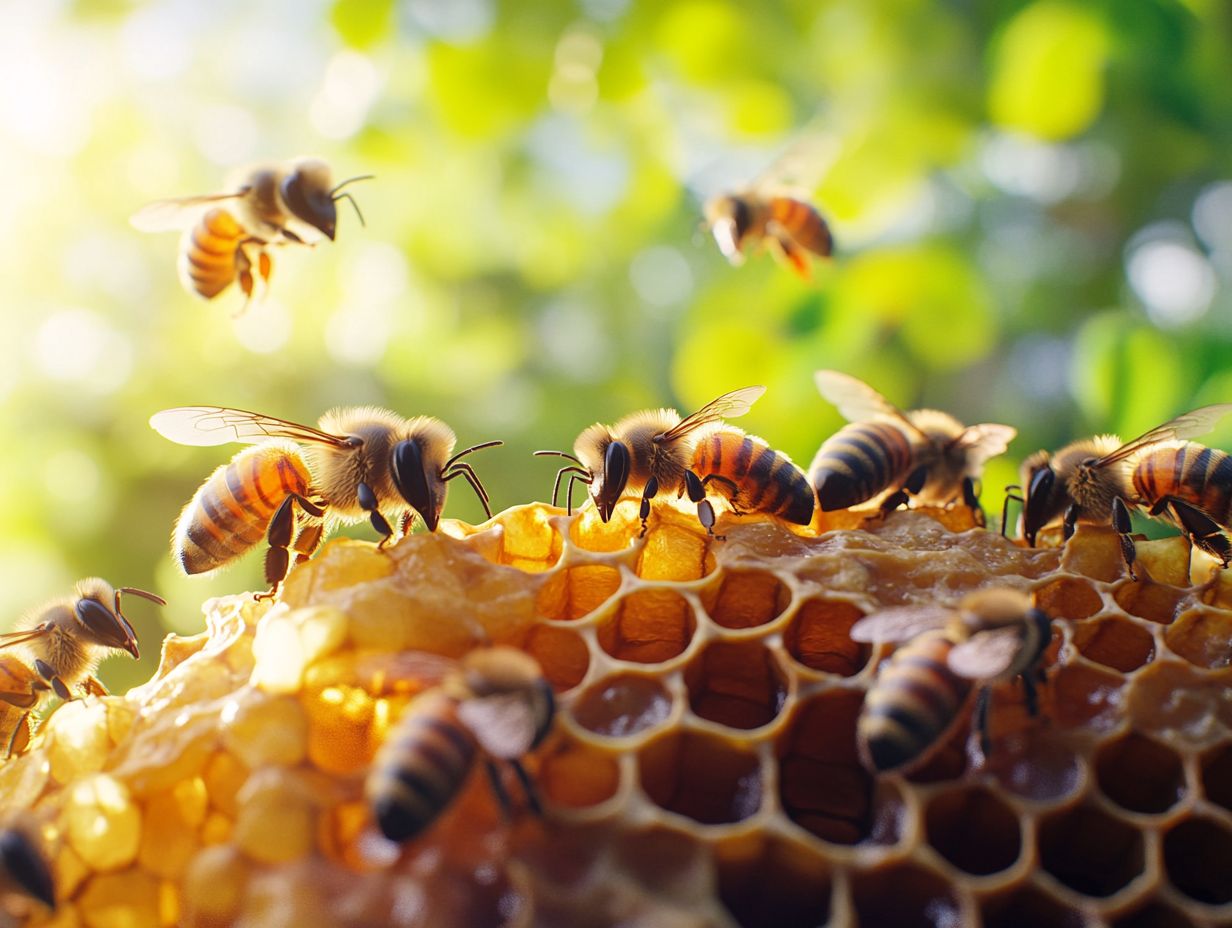
Drone bees bring vital genetic diversity that strengthens your colony’s health and resilience! This diversity is crucial in combating threats like varroa mites, which are pests that can harm bee colonies.
When a queen mates with multiple drone bees during her nuptial flights, she accumulates a rich gene pool that significantly enhances the genetic makeup of her progeny. This diverse lineage fosters vital traits such as disease resistance, foraging efficiency, and overall colony vigor.
A genetically diverse colony is far better equipped to tackle challenges like climate fluctuations and the presence of pathogens. Such robustness stabilizes the hive and ensures greater productivity, resulting in more abundant honey production and effective pollination services both crucial for the surrounding ecosystem.
Interested in supporting bee health? Discover tips on creating a bee-friendly garden!
Temperature Regulation
Drone bees play a pivotal role in temperature regulation within the hive, working alongside worker bees to maintain an ideal environment for brood development through their collective thermoregulation efforts. Their activities, including swarming and clustering, contribute to this process.
Your attention to their collaborative activities reveals how they create a microclimate that is vital for ensuring the right temperature and humidity levels necessary for healthy larvae growth. Worker bees engage in air circulation by fanning their wings to evaporate excess moisture, while drones contribute by clustering together to generate warmth during cooler periods. This process also helps in maintaining the hive’s beeswax structure.
This remarkable teamwork sustains temperatures between 32 C and 36 C, creating the perfect conditions for developing brood. Proper temperature control not only enhances the health of the brood but also significantly boosts hive productivity. A well-regulated environment facilitates efficient foraging, grooming, and food storage activities, all of which are essential for the colony’s overall success.
Aiding in Queen Mating
Drone bees play a vital role in supporting the queen during her mating flights, as they are the exclusive males tasked with fertilizing her eggs. This process is essential for maintaining genetic diversity within the colony. Queen pheromones play a significant role in attracting drones during these flights.
These mating flights typically take place in designated areas known as drone congregation areas, where males eagerly gather, awaiting the queen s arrival. During these flights, the queen mates with multiple drones, significantly enhancing the genetic variability of the colony. This genetic mixing not only bolsters the overall health and resilience of the hive but also equips future generations to adapt to environmental changes and fend off diseases.
Maintaining such diversity within the bee population is crucial, as it can profoundly influence the long-term survival and productivity of the colony.
How to Identify Drone Bees in a Hive
Identifying drone bees in a hive becomes a straightforward task when you observe their distinct physical characteristics and behavioral differences from worker bees. This clarity allows you to monitor hive dynamics with greater ease and precision, enhancing your beekeeping experience. Also, understanding the drone lifespan and their reproductive organs is essential for effective hive management.
Physical Characteristics
You can easily identify drone bees by their larger size, robust bodies, and the notable absence of stingers, which sets them apart from both worker bees and the queen bee. Their presence is crucial for the mating process and overall colony health.
Typically, you’ll find that drone bees are bulkier and longer than their worker counterparts, often measuring about 1.5 times the size of a worker bee. Their bodies have a rounder, stockier appearance, while worker bees sport more slender bodies designed for foraging and pollen collection. Drones, on the other hand, are specifically built for mating, which is why they have a smoother, elongated abdomen.
In terms of coloration, drones generally showcase a more vibrant yellow and black banding pattern compared to the muted tones of worker bees. The absence of a stinger is yet another striking difference; while worker bees are equipped with this defense mechanism, drones completely lack it, further emphasizing their unique role within the hive.
Behavioral Differences
Drone bees showcase fascinating behavior, particularly during mating season. They eagerly flock to drone congregation areas to mate with the queen.
These areas are typically found in open spaces, where numerous drones gather, all vying for the chance to attract a queen on her mating flight. Unlike industrious worker bees, which are busy foraging, nursing, and maintaining the hive, the sole focus of drone bees is reproduction.
Their role is important, as they enhance the variation in genes that helps the bee colony survive through mating. They remain aloof from the daily toil and responsibilities of hive life.
The contrast between the drones and the workers highlights the unique specialization within the hive, with each group fulfilling essential yet distinctly different functions to sustain and propagate the colony.
How to Manage Drone Bees in a Hive
Managing drone bees within a hive is key for maintaining a harmonious colony. As a beekeeper, it’s important to employ various strategies to control their population, ensure proper nutrition, and replace old or ineffective drones to enhance the health and productivity of your hive.
Controlling Drone Population
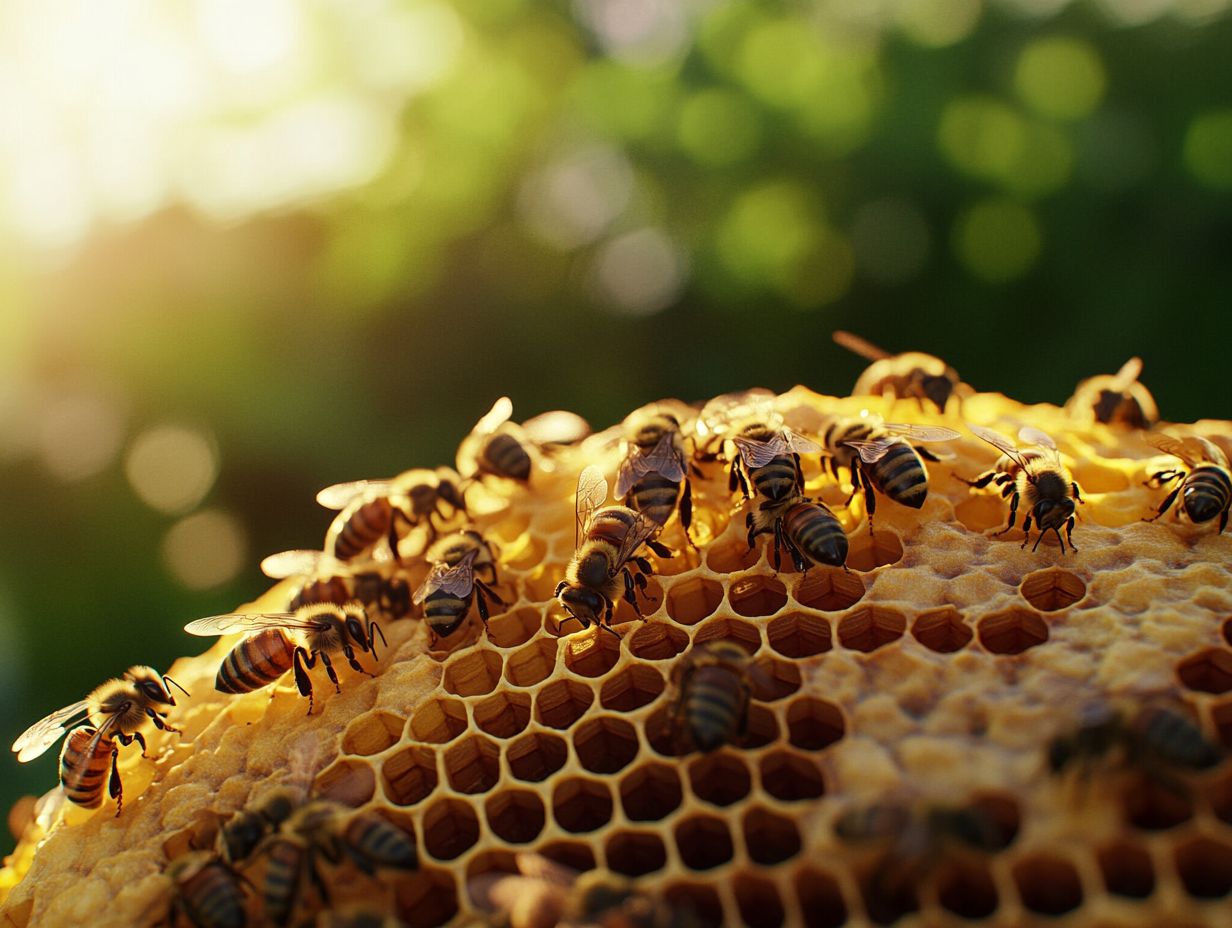
Controlling the drone population in a hive is essential. Too many drones can deplete resources and disrupt the delicate balance within the colony.
As a beekeeper, you need to be vigilant in recognizing the signs of an overabundant drone population. Pay close attention to changes in behavior, such as heightened aggression among worker bees or a noticeable decline in honey production.
The queen plays an important role in this dynamic; her egg-laying patterns dictate the number of drones. When conditions call for it, especially during times of resource scarcity, she may stop producing new drones entirely.
Maintaining this balance is vital since a reduction in drones impacts the responsibilities of worker bees and can shift the entire hive’s dynamics, ultimately affecting the resources available for other vital activities.
Replacing Old Drones
Replacing old drones is an exciting part of your hive management strategy. You need healthier and more vigorous drones to ensure successful mating with the queen.
As these drones age, their ability to fly and compete for mating opportunities diminishes. Keep a vigilant eye on the hive for any signs of declining vigor. Typically, older drones will show reduced mobility and a noticeable drop in activity around the hive.
The queen bee plays a crucial role; she instinctively understands the importance of mating with stronger drones to sire her offspring.
The process of replacing drones guarantees a steady supply of high-caliber drones and bolsters the overall vitality of your colony. This enhances its resilience against environmental challenges. Healthy drones contribute to better genetic diversity, which is essential for maintaining a robust and thriving beehive.
Ensuring Proper Nutrition
Ensuring that drone bees receive proper nutrition is essential. Their health has a direct impact on the productivity and overall well-being of the colony.
These bees predominantly depend on a diet abundant in pollen and nectar, both of which are crucial for their development and energy requirements.
Pollen acts as a vital source of protein, providing necessary amino acids, while nectar delivers carbohydrates that energize their daily activities. Healthy drones not only enhance mating success with queens but also play an integral role in the hive’s ecosystem by supporting pollination efforts.
It’s imperative for the hive to maintain a consistent supply of these food resources. This safeguard is particularly important during foraging seasons or adverse weather conditions when resources may dwindle. Ensuring the colony’s health and functionality remain intact is vital.
Monitoring for Disease and Parasites
Monitoring your drone bees for signs of disease and parasites is crucial for maintaining your hive’s overall health. Their presence often serves as an early warning system, indicating potential threats that could jeopardize the entire colony.
Drone bees, in particular, are susceptible to common threats like varroa mites. These pests attach to the bees and feed on their bodily fluids. This weakens the bees’ immune systems. If diseases such as nosema or foulbrood go unchecked, they can spread rapidly throughout the colony.
To safeguard your hive, it s important to implement proactive measures. Regular inspections and simple pest control methods that combine different techniques will enable you to keep a vigilant eye on your drone populations.
Consider utilizing treatment options like organic acids or essential oils to help manage these infestations. By taking these steps, you can ensure your hive’s health and support the ongoing success of your pollination efforts.
The Future of Drone Bees in Hive Management
The future of drone bees in hive management is being revolutionized by cutting-edge technological advancements and continuous research efforts. These developments deepen your understanding of their vital roles while enhancing your beekeeping practices.
However, it’s important to remain aware of the challenges posed by environmental and health factors that can impact their effectiveness.
Technological Advancements
Technological advancements in hive monitoring and data analysis are transforming the way you manage drone bees and the overall health of your hives.
Innovative sensors can measure temperature, humidity, and movement within the hive. This allows you to gain real-time insights into hive conditions.
These advanced tools allow you to track drone bee populations, ensuring that you can swiftly identify any imbalances or issues that may arise.
Aerial drones equipped with high-resolution cameras provide an external perspective on hive placement and the surrounding environment. This facilitates more effective management strategies.
When combined with sophisticated data analytics software, these technologies enable you to make informed, data-driven decisions. This significantly enhances your ability to maintain healthy and productive colonies.
Impact on Beekeeping Industry
The management of drone bees is gaining recognition for its profound impact on the beekeeping industry, drawing your attention to the critical importance of hive dynamics and overall health.
By strategically managing drones, you can significantly enhance colony vitality and productivity. This ultimately leads to improved honey yields and stronger hive populations.
This approach is not only economically advantageous, offering more efficient pollination services, but it also supports sustainable beekeeping practices.
In today s landscape, modern beekeepers like you face numerous challenges, from environmental pressures to threats posed by diseases. Understanding the role of drones in our ecosystem is now more exciting and essential than ever!
As the industry continues to evolve, effectively managing these essential bees will be vital for ensuring healthy colonies and fostering long-term viability in an increasingly complex agricultural environment.
Start monitoring your drone bees today to ensure a thriving hive!
Challenges and Solutions
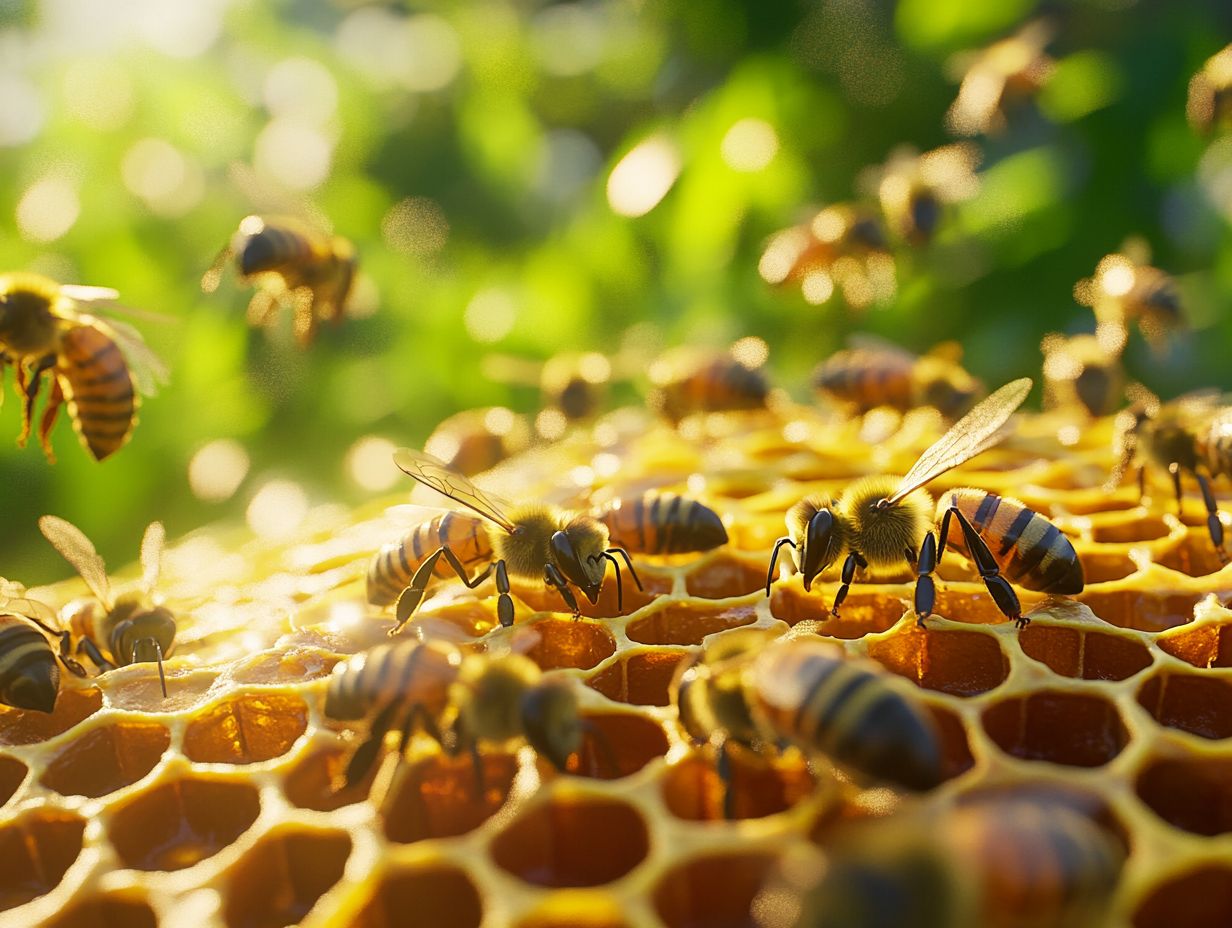
The challenges you face with drone bees in hive management such as disease threats and environmental changes demand innovative solutions. These solutions are essential to ensure the sustainability of bee populations and the overall health of your hives.
To tackle these urgent issues, it s essential for you to deepen your understanding of the impact of parasites, particularly varroa mites. These mites have wreaked havoc on colonies worldwide. Implementing effective methods to control pests could be vital, along with breeding bees that can resist mites, which helps them survive better.
As climate change continues to disrupt pollination patterns and forage availability, promoting habitat diversity and planting climate-resilient flora will be key in supporting the well-being of both drone bees and the broader ecological community. It s crucial to adapt quickly to these changes to ensure the health of our bee populations.
By combining these efforts, you can significantly contribute to sustaining hive health and enhancing bee resilience in the face of escalating challenges.
Frequently Asked Questions
What is the role of drone bees in hive management and hive activity?
Drone bees are male bees that have one main purpose in the hive: to mate with the queen bee. They play a vital role in the reproductive process, including mating flights, and do not have any other responsibilities, such as hive cleaning or honey production.
How do drone bees contribute to the health of the colony?
Drone bees contribute to the genetic diversity of the hive by mating with different queens from other hives. This helps prevent inbreeding and strengthens the overall health of the colony. The mating process typically occurs in drone congregation areas.
Are drone bees necessary for a functioning colony?
While drone bees are not essential for the survival of the hive, they play a crucial role in maintaining a healthy and productive colony. Without them, the queen would not be able to lay fertilized eggs, leading to a decline in the colony’s population and overall health.
Do drone bees collect nectar or pollen like worker bees or foragers?
No, drone bees do not collect nectar or pollen like worker bees or foragers. They lack the specialized body parts, such as pollen baskets, to carry these materials back to the hive. Their primary role involves activities related to the mating process and genetic diversity.
How many drone bees are typically found in a colony?
Did you know the number of drone bees in a hive changes with the seasons? The number varies depending on the time of year, but in general, there are significantly fewer drones than worker bees or female bees. During the peak of the summer season, a hive may have around 500 to 1000 drone bees, primarily occupying drone cells.
What happens to drone bees at the end of the season and to their drone lifespan?
As the colder months approach, worker bees will begin to kick out the male drones from the hive. Drones are no longer needed for mating and do not contribute to the hive’s productivity or survival during winter. Drones do not engage in comb building, hive maintenance, or temperature regulation. Eventually, the drones will die off, and the cycle will repeat itself in the spring.

